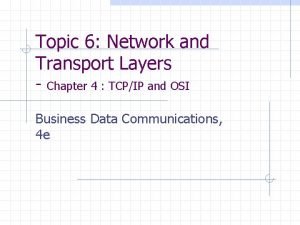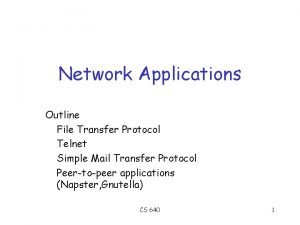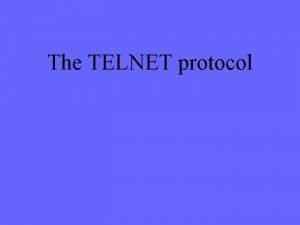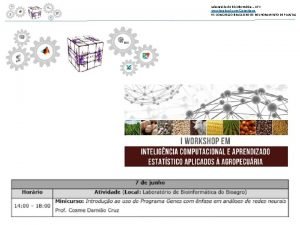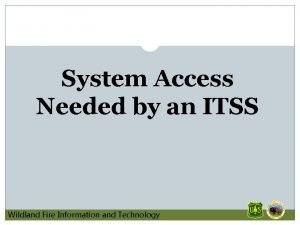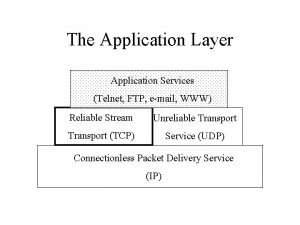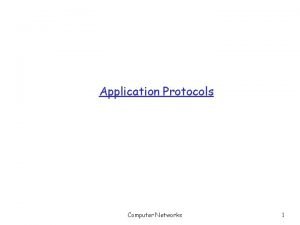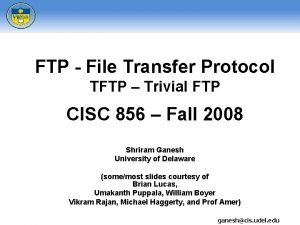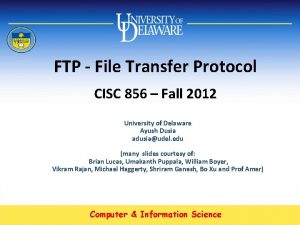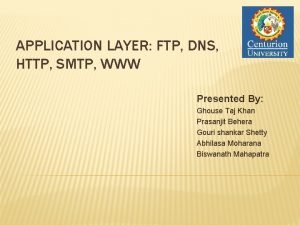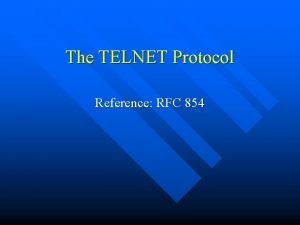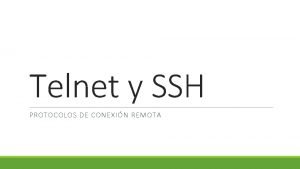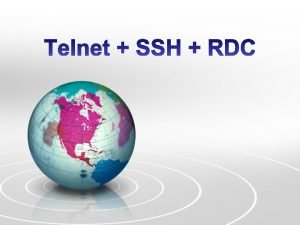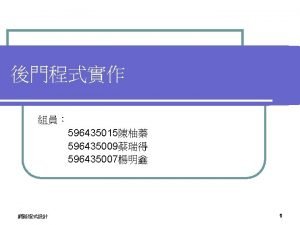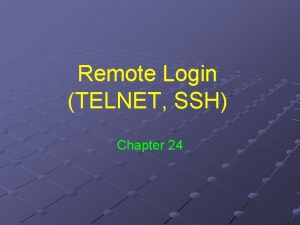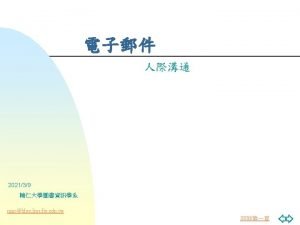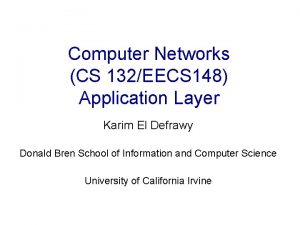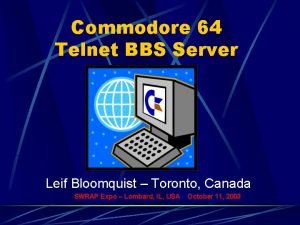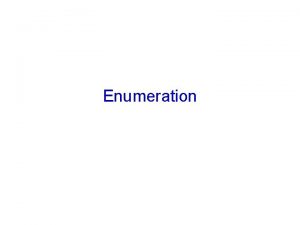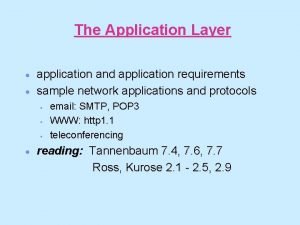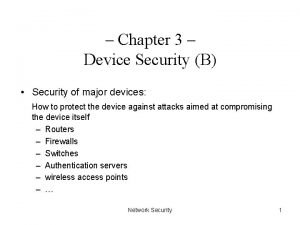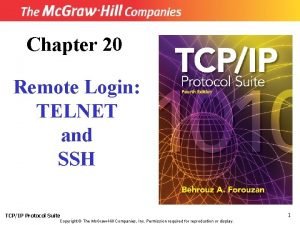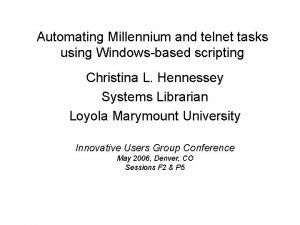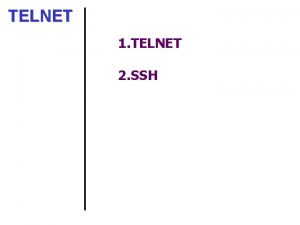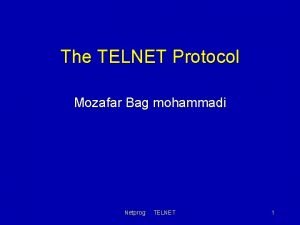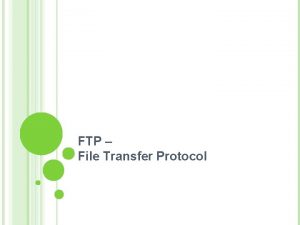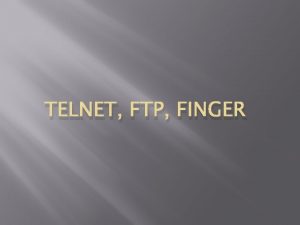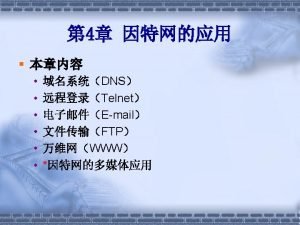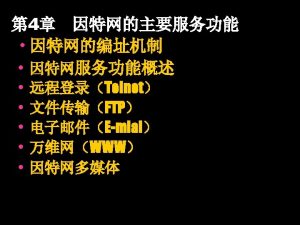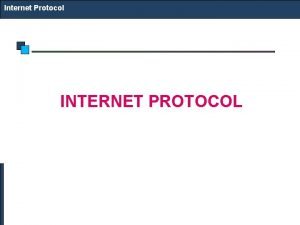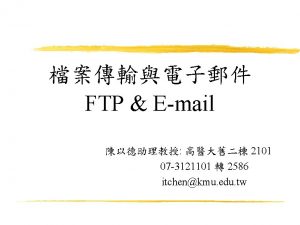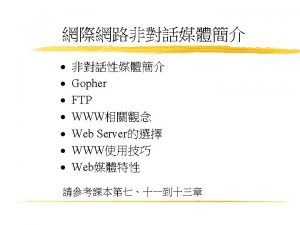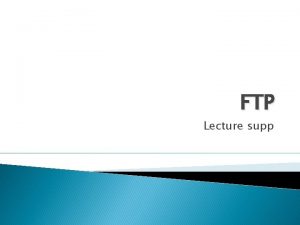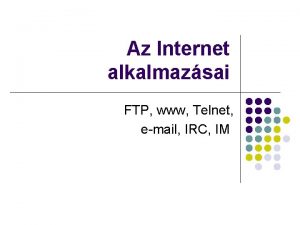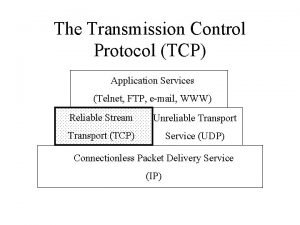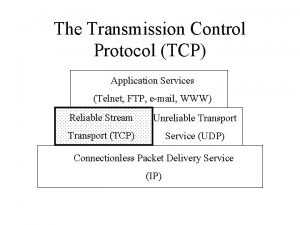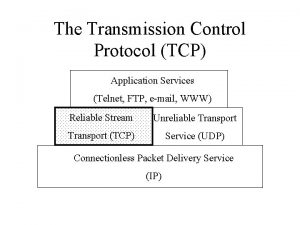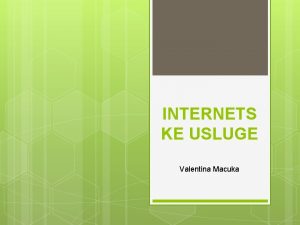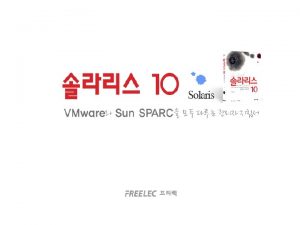The Internet Protocol IP Application Services Telnet FTP

























- Slides: 25

The Internet Protocol (IP) Application Services (Telnet, FTP, e-mail, WWW) Reliable Transport Service (TCP) Connectionless Packet Delivery Service (IP)

The Internet Protocol (IP) • Provides a packet delivery service which is: – Unreliable – Best-effort – Connectionless • Defines the basic unit of data transfer • Performs the routing function • Includes a set of rules that embody the idea of unreliable packet delivery

IP Datagrams • The basic unit of data transfer Frame Header Datagram Header Frame Datagram Datagram Frame Physical Network Internet

IP Datagram Format

IP Datagram Service Type Field 0 VERS 1 2 3 4 PRECEDENCE D T HLEN SERVICE TYPE 5 R 6 7 UNUSED TOTAL LENGTH 16 bits

IP Datagram Service Type Field • In the 1990’s the meaning of the service type field was redefined: • For backwards compatibility: – When the last three codepoint bits are zero, the first three bits represent 8 classes of service (0 = least important, …, 7 = most important)

IP Datagram Encapsulation Datagrams must move from machine to machine via physical networks Datagram Header Frame Header Datagram Data Frame Data What if a datagram won’t fit in a frame?

Maximum Transfer Unit (MTU) • Each physical networking technology limits the amount of data that can fit in a frame – Ethernet: 1500 octets – FDDI: 4470 octets • This is called the network’s MTU • Limiting datagrams to fit in the smallest possible MTU would make travelling across networks with a larger MTU inefficient • Allowing datagrams to be larger than a network’s MTU means that datagrams will not always fir in a single frame

Datagram Fragmentation • Divide datagrams too large to fit in one frame into pieces called fragments • Each fragment should fit into one frame • Transport fragments over physical network • Reassemble fragments into the complete datagram

Datagram Fragmentation (cont)

Datagram Fragmentation Example Datagram Header Data (4000 octets) Fragment 1 Header Data (1480 octets) Fragment 2 Header Data (1480 octets) Fragment 3 Header Data (1040 octets) Fragment headers duplicate datagram’s header (except for FLAGS field)

Datagram Format Flags = DNF, FRAG, MF

Reassembly of Fragments • Should fragments be reassembled after crossing one network or should we wait until the fragments arrive at their final destination to reassemble them? • Advantages? • Disadvantages?

Internet Datagram Options • Used for network testing and debugging • Variable length field (depending on what options are selected) 0 Copy 1 2 Class 3 4 5 6 7 Option number • Classes: – 0: Datagram or network control – 2: Debugging and measurement 1: Reserved for future use 3: Reserved for future use

Internet Datagram Options (cont) 0 Copy 1 2 3 Class 4 6 7 Option number • Class 0 option numbers: – – – – 5 0: End of options list 1: No operation 2: Security and handling restrictions 3: Loose source routing 7: Record route 8: Stream identifier 9: Strict source routing Class 2 option numbers: - 4: Internet timestamp

The Record Route Option • Source creates an empty list of IP addresses in the header • Set Record route option • Each router that handles the datagram appends its IP address to the list • Destination machine can extract and process the route information

Source Route Option • Sender dictates a path through the internet over which the datagram must travel • Sender lists IP addresses (in order) of the route the datagram should take • Sender sets the source route option

Source Route Option (cont) • Strict source routing - the path between two successive addresses in the list must consist of a single physical network • Loose source routing – The datagram must follow the sequence of IP addresses in the list – Allows multiple network hops between successive addresses on the list

The Timestamp Option • Sender creates an empty list in the header • Sender enables the timestamp option • Each router that handles the datagram appends to the list its: – IP address – Local timestamp (in Universal Time)

Processing Options During Fragmentation 0 Copy 1 2 3 Class 4 6 7 Option number • Class 0 option numbers: – – – – 5 0: End of options list 1: No operation 2: Security and handling restrictions 3: Loose source routing 7: Record route 8: Stream identifier 9: Strict source routing Class 2 option numbers: - 4: Internet timestamp

Processing Options During Fragmentation (cont) • When fragmenting a datagram a router: – Replicates some IP options in all fragments • Example? – Replicates some IP options in only one fragment • Example?

IP – Security Issues • Destination IP address is used to route a datagram to its final destination • Source IP address identifies the sender so that the receiver knows where to send a reply • IP spoofing – sender of a datagram inserts the address of another machine (or a nonexistent machine) in the source address field – Prevent the receiver from determining the host from which an attack datagram originated – Make the message appear to have originated from a trusted machine – Want reply sent to a another (victim) host

Teardrop • Tool enabled attackers to crash vulnerable remote systems by sending a certain type of fragmented IP datagram – Normal datagram fragments do not overlap – Teardrop created fragments that did overlap – Some implementations of the TCP/IP IP fragmentation reassembly code do not properly handle overlapping IP fragments • Windows and some Linux kernels – Caused system to crash – Fixed by software patches

Summary • The Internet Protocol (IP): – Provides a packet delivery service which is: • Unreliable • Best-effort • Connectionless – Defines the basic unit of data transfer – Performs the routing function – Includes a set of rules that embody the idea of unreliable packet delivery

Summary (cont) Application Services (Telnet, FTP, e-mail, WWW) Reliable Transport Service (TCP) Connectionless Packet Delivery Service (IP)
 Ftp, telnet belongs to which layer in edi architecture?
Ftp, telnet belongs to which layer in edi architecture? Telnet send file
Telnet send file Telnet protocol
Telnet protocol Facebook
Facebook Nwcg ftp
Nwcg ftp Telnet application layer
Telnet application layer In ftp protocol client contacts server using
In ftp protocol client contacts server using Trivial ftp
Trivial ftp Purpose of ftp protocol
Purpose of ftp protocol Smtp application layer
Smtp application layer Rfc 854
Rfc 854 Protocolos telnet
Protocolos telnet Telnet adalah
Telnet adalah Telnet backdoor
Telnet backdoor Telnet sql
Telnet sql Remote login telnet
Remote login telnet Telnet imap
Telnet imap Telnet cis.poly.edu 80
Telnet cis.poly.edu 80 Telnet bbs
Telnet bbs Telnet rlogin
Telnet rlogin Telnet enumeration
Telnet enumeration Telnet gaia.cs.umass.edu 80
Telnet gaia.cs.umass.edu 80 Reverse telnet cisco aux to console
Reverse telnet cisco aux to console Ssh packet format
Ssh packet format Autoit telnet
Autoit telnet Security architecture for the internet protocol
Security architecture for the internet protocol
